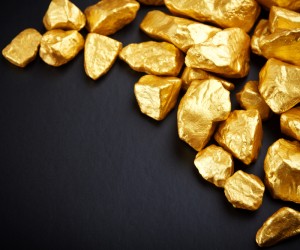Want to learn more about gold production in Canada? Read on for facts and info on the production of gold in Canada…
In Canada gold was discovered in 1823 along the banks of the Rivière Chaudière in the Eastern Townships of Québec. After the famous goldrush in California and Australia in 1858, discovery of gold on the sands of the Fraser River in the interior of British Columbia started the Caribou gold rush and of course around 40 years later the legendary Klondike Gold Rush in the Yukon marked the beginning of the most profitable time in Canadian gold mining history. The annual gold production in Canada today is approximately 160,000 kg.
The periodic table symbolizes gold as Au. Gold is a shiny, lustrous, yellow colored metal which is recognized for its high density and is produced in bulk quantities in Canada.
It is 19.3 times the weight of an equal volume of water and is highly valued for its strong resistance to corrosion, ductility, brightness and rarity. Fools Gold or Pyrite can be identified and distinguished from the original one by comparing its brittleness and hardness, and the fact that it is black in color when in powder form.
Since it does not react chemically like most other metals do it is usually found in an uncombined and free state in nature, usually in the form of flakes, dust in gravel and sand along creeks and rivers and also as Nuggets. The best source of gold is from the veins in bedrock which are called lodes. It is also produced as a byproduct of the mines which are home to base metals and approximately 1/5 of Canada’s gold production is found from this source.
Gold Production in Canada
There are many ways in which gold can be separated and recovered and the process used is dependent on the nature of the ore. If it occurs in a relatively coarse and free state it can be recovered through mechanical means like using shaking tables and gravity traps which allow the gold to separate due to its high specific gravity.
The chemical process used to recover gold which is very finely distributed in the ore is called cyanidation. In this process cyanide solution is added to finely ground ore and the product is agitated in air to dissolve the gold. After following few specific treatment steps the solution which contains the gold is clarified and zinc dust is added to the solution to precipitate the gold. You do not require filtration of the ground ore slurry in this process as activated carbon is used to filter the gold, and the activated carbon is stripped of the gold in an acid bath and then recycled.
After the gold is separated from the ore and it is still in the form of an impure precipitate it is mixed with a fluxing agent and put in a high-temperature furnace. Then a chemical reaction takes place and the flux and impurities combine to form slag allowing the molten gold to sink to the bottom of the furnace. Here it is drawn out and poured into molds to form doré bars which consist of the gold and any silver that may be present in the original ore.





